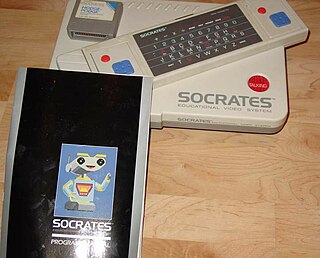Multimedia is a form of communication that combines different content forms such as text, audio, images, animations, or video into a single presentation, in contrast to traditional mass media, such as printed material or audio recordings. Popular examples of multimedia include video podcasts, audio slideshows, animated shows, and movies.
Educational software is a term used for any computer software which is made for an educational purpose. It encompasses different ranges from language learning software to classroom management software to reference software, etc. The purpose of all this software is to make some part of education more effective and efficient.
Educational games are games explicitly designed with educational purposes, or which have incidental or secondary educational value. All types of games may be used in an educational environment, however Educational games are games that are designed to help people learn about certain subjects, expand concepts, reinforce development, understand a historical event or culture, or assist them in learning a skill as they play. Game types include board, card, and video games. As educators, governments, and parents realize the psychological need and benefits that gaming has on learning, this educational tool has become mainstream. Games are interactive play that teach us goals, rules, adaptation, problem solving, interaction, all represented as a story. They satisfy our fundamental need to learn by providing enjoyment, passionate involvement, structure, motivation, ego gratification, adrenaline, creativity, social interaction and emotion in the game itself while the learning takes place.
Situated learning is a theory that explains an individual's acquisition of professional skills and includes research on apprenticeship into how legitimate peripheral participation leads to membership in a community of practice. Situated learning "takes as its focus the relationship between learning and the social situation in which it occurs".

Active learning is "a method of learning in which students are actively or experientially involved in the learning process and where there are different levels of active learning, depending on student involvement." Bonwell & Eison (1991) states that "students participate [in active learning] when they are doing something besides passively listening." In a report from the Association for the Study of Higher Education (ASHE), authors discuss a variety of methodologies for promoting active learning. They cite literature that indicates students must do more than just listen in order to learn. They must read, write, discuss, and be engaged in solving problems. This process relates to the three learning domains referred to as knowledge, skills and attitudes (KSA). This taxonomy of learning behaviors can be thought of as "the goals of the learning process." In particular, students must engage in such higher-order thinking tasks as analysis, synthesis, and evaluation.
Kinesthetic learning, kinaesthetic learning, or tactile learning is a learning style in which learning takes place by the students carrying out physical activities, rather than listening to a lecture or watching demonstrations. As cited by Favre (2009), Dunn and Dunn define kinesthetic learners as students who require whole-body movement to process new and difficult information.
M-learning or mobile learning is "learning across multiple contexts, through social and content interactions, using personal electronic devices". A form of distance education, m-learners use mobile device educational technology at their convenient time.
Educational technology is the combined use of computer hardware, software, and educational theory and practice to facilitate learning. Educational technology creates, uses, and manages technological processes and educational resources to help improve user academic performance.
Business simulation is simulation used for business training, education or analysis. It can be scenario-based or numeric-based.
Computer-supported collaborative learning (CSCL) is a pedagogical approach wherein learning takes place via social interaction using a computer or through the Internet. This kind of learning is characterized by the sharing and construction of knowledge among participants using technology as their primary means of communication or as a common resource. CSCL can be implemented in online and classroom learning environments and can take place synchronously or asynchronously.

An educational video game is a video game that provides learning or training value to the player. Edutainment describes an intentional merger of video games and educational software into a single product. In the narrower sense used here, the term describes educational software which is primarily about entertainment, but tends to educate as well and sells itself partly under the educational umbrella. Normally software of this kind is not structured towards school curricula and does not involve educational advisors.
A serious game or applied game is a game designed for a primary purpose other than pure entertainment. The "serious" adjective is generally prepended to refer to video games used by industries like defense, education, scientific exploration, health care, emergency management, city planning, engineering, and politics. Serious games are a subgenre of serious storytelling, where storytelling is applied "outside the context of entertainment, where the narration progresses as a sequence of patterns impressive in quality ... and is part of a thoughtful progress". The idea shares aspects with simulation generally, including flight simulation and medical simulation, but explicitly emphasizes the added pedagogical value of fun and competition.
A simulation game is "a game that contains a mixture of skill, chance, and strategy to simulate an aspect of reality, such as a stock exchange". Similarly, Finnish author Virpi Ruohomäki states that "a simulation game combines the features of a game with those of a simulation. A game is a simulation game if its rules refer to an empirical model of reality." A properly built simulation game used to teach or learn economics would closely follow the assumptions and rules of the theoretical models within this discipline.

Computers in the classroom include any digital technology used to enhance, supplement, or replace a traditional educational curriculum with computer science education. As computers have become more accessible, inexpensive, and powerful, the demand for this technology has increased, leading to more frequent use of computer resources within classes, and a decrease in the student-to-computer ratio within schools.

David Williamson Shaffer is the Vilas Distinguished Achievement Professor of Learning Science at the University of Wisconsin–Madison in the department of Educational Psychology, the Obel Foundation Professor of Learning Analytics at Aalborg University in Copenhagen, a Data Philosopher at the Wisconsin Center for Education Research, and Principal of EFGames, LLC.

A flipped classroom is an instructional strategy and a type of blended learning, which aims to increase student engagement and learning by having students complete readings at their home and work on live problem-solving during class time.

The gamification of learning is an educational approach to motivate students to learn by using video game design and game elements in learning environments. The goal is to maximize enjoyment and engagement through capturing the interest of learners and inspiring them to continue learning. Gamification, broadly defined, is the process of defining the elements which comprise games that make those games fun and motivate players to continue playing, and using those same elements in a non-game context to influence behaviour. In other words, gamification is the introduction of game elements in a non-game situation.

Kahoot! is a game-based learning platform, used as educational technology in schools and other educational institutions. Its learning games, "kahoots", are user-generated multiple-choice quizzes that can be accessed via a web browser or the Kahoot app.
Games and learning is a field of education research that studies what is learned by playing video games, and how the design principles, data and communities of video game play can be used to develop new learning environments. Video games create new social and cultural worlds – worlds that help people learn by integrating thinking, social interaction, and technology, all in service of doing things they care about. Computers and other technologies have already changed the way students learn. Integrating games into education has the potential to create new and more powerful ways to learn in schools, communities and workplaces. Games and learning researchers study how the social and collaborative aspects of video game play can create new kinds of learning communities. Researchers also study how the data generated by game play can be used to design the next generation of learning assessments.
Social media in education refers to the practice of using social media platforms as a way to enhance the education of students. Social media is defined as "a group of Internet-based applications that build on the ideological and technological foundations of Web 2.0, and that allow the creation and exchange of user-generated content".






